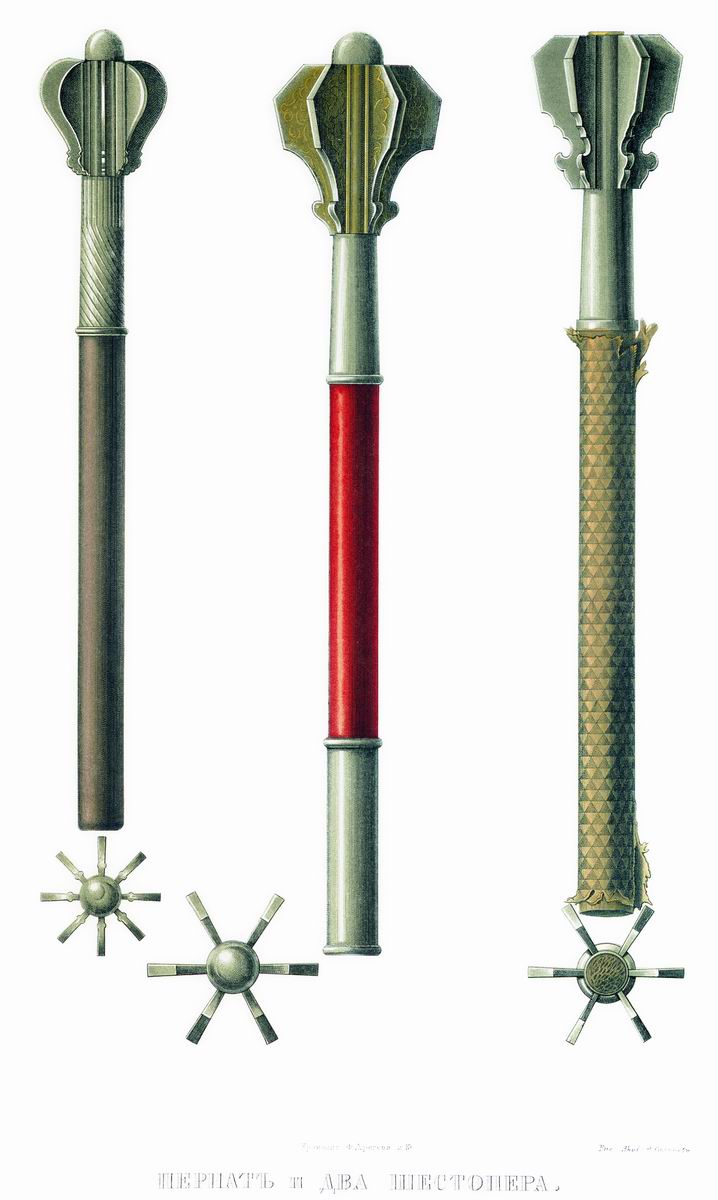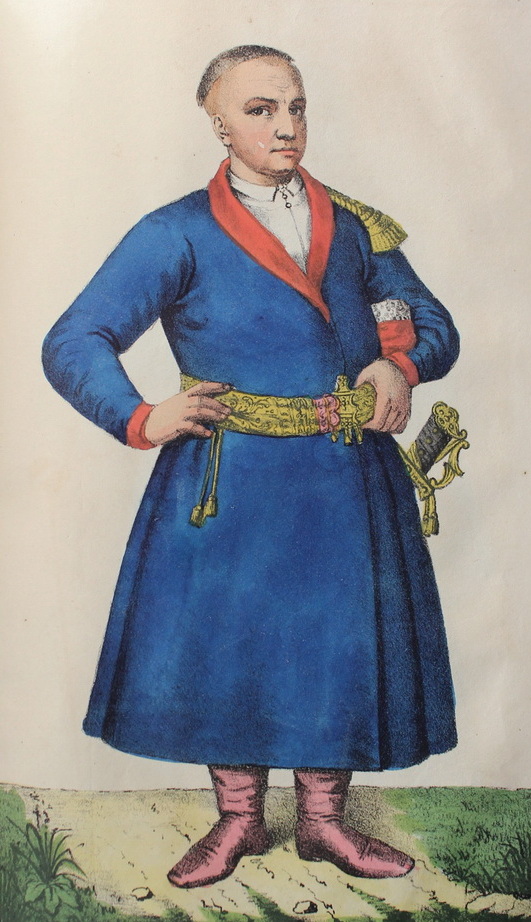|
Pernach
A pernach (russian: перна́ч, uk, перна́ч or , pl, piernacz) is a type of mace (bludgeon), flanged mace originating in the 12th century in the region of Kievan Rus' and later widely used throughout Europe. The name comes from the Slavic word ''перо'' (''pero'') meaning feather, referring to a type of pernach resembling an arrow with Fletching, feathering. Among a variety of similar weapons developed in 12th-century Persian- and Turkic peoples, Turkic-dominated areas, the pernach became pre-eminent, being capable of penetrating plate armour and plate mail. A pernach or shestoper ( uk, шестопeр, "six-feathered") was often carried as a ceremonial mace of rank by certain Eastern European military commanders, including Poles, Polish magnates, Ukrainian people, Ukrainian Cossack colonels and sotniks (cf. centurion). In Ukraine it symbolized the authority of Colonels (polkovnyk, regional leaders or military officers) [...More Info...] [...Related Items...] OR: [Wikipedia] [Google] [Baidu] |
Mace (bludgeon)
A mace is a blunt weapon, a type of club or virge that uses a heavy head on the end of a handle to deliver powerful strikes. A mace typically consists of a strong, heavy, wooden or metal shaft, often reinforced with metal, featuring a head made of stone, bone, copper, bronze, iron, or steel. The head of a military mace can be shaped with flanges or knobs to allow greater penetration of plate armour. The length of maces can vary considerably. The maces of foot soldiers were usually quite short (two or three feet, or sixty to ninety centimetres). The maces of cavalrymen were longer and thus better suited for blows delivered from horseback. Two-handed maces could be even larger. Maces are rarely used today for actual combat, but many government bodies (for instance, the British House of Commons and the U.S. Congress), universities and other institutions have ceremonial maces and continue to display them as symbols of authority. They are often paraded in academic, parliamentary or ... [...More Info...] [...Related Items...] OR: [Wikipedia] [Google] [Baidu] |
Medieval Weapons
The following is a list of Wikipedia articles of the types of weapons that were in use during the post-classical historical period (roughly between the mid 1st to mid 2nd millennia AD). Offensive weapons Melee weapons Trauma and cleaving weapons * Battle axe * Bec de corbin * Bludgeon * Club * Flail * Flanged mace * Horseman's pick * Mace * Morning star * Quarterstaff * Shestopyor, Pernach * War hammer Swords and hilt weapons Swords can have single or double bladed edges or even edgeless. The blade can be curved or straight. * Arming sword * Dagger * Estoc * Falchion * Katana * Knife * Longsword * Rapier * Sabre or Saber (Most sabers belong to the renaissance period, but some sabers can be found in the late medieval period) * Shortsword * Ulfberht (Frankish) Spears and polearms * Ahlspiess * Bardiche * Bec de Corbin * Bill * Glaive * Goedendag * Guisarme * Halberd * Lance * Lochaber axe * Lucerne hammer * Man catcher * Military fork * Partisan * Pike ... [...More Info...] [...Related Items...] OR: [Wikipedia] [Google] [Baidu] |
Bulawa
The bulava or buława (Polish spelling: ''buława''; Ukrainian spelling: ''булава'' 'bula'va'' is a ceremonial mace or baton or sceptre. Poland, Grand Duchy of Lithuania, Polish–Lithuanian Commonwealth Historically the ''buława'' was an attribute of a hetman, an officer of the highest military rank (after the monarch) in the 15th- to 18th-century Kingdom of Poland and the Polish–Lithuanian Commonwealth. Hetmans typically added an image of a ''buława'' to their coats of arms. Today the ''buława'' appears in the rank insignia of a Marshal of Poland. Ukraine In the Ukrainian language, a ''булава'' (bulava) is a mace or club, in both the military and ceremonial senses. The ''bulava'' was one of the Ukrainian Cossack ''kleinody'' (клейноди - "regalia", or literally: "jewels"): Bohdan Khmelnytsky bore a ''bulava'' as Hetman of the Zaporizhian Host (in office: 1648 to 1657). [...More Info...] [...Related Items...] OR: [Wikipedia] [Google] [Baidu] |
Clubs (weapon)
Club may refer to: Arts, entertainment, and media * ''Club'' (magazine) * Club, a ''Yie Ar Kung-Fu'' character * Clubs (suit), a suit of playing cards * Club music * "Club", by Kelsea Ballerini from the album ''kelsea'' Brands and enterprises * Club (cigarette), a Scottish brand of cigarettes * Club (German cigarette), a German brand of cigarettes * Club Med, a holiday company Food * Club (soft drink) * Club Crackers * Club sandwich * Club (biscuit), a brand of biscuits manufactured by Jacob's (Ireland) and McVitie's (UK) Objects * Club (weapon), a blunt-force weapon * Golf club * Indian club, an exercise device * Juggling club * Throwing club, an item of sport equipment used in the club throw * Throwing club, an alternative name for a throwing stick Organizations * Club (organization), a type of association * Book discussion club, also called a book club or reading circle * Book sales club, a marketing mechanism * Cabaret club * Gentlemen's club (traditional) * Health club ... [...More Info...] [...Related Items...] OR: [Wikipedia] [Google] [Baidu] |
Polkovnyk
''Polkovnik'' (russian: полковник, lit=regimentary; pl, pułkownik) is a military rank used mostly in Slavic-speaking countries which corresponds to a colonel in English-speaking states and oberst in several German-speaking and Scandinavian countries. The term originates from an ancient Slavic word for a group of soldiers and folk. However, in Cossack Hetmanate and Sloboda Ukraine, ''polkovnyk'' was an administrative rank similar to a governor. Usually this word is translated as colonel, however the transliteration is also in common usage, for the sake of the historical and social context. ''Polkovnik'' began as a commander of a distinct group of troops (''polk''), arranged for battle. The exact name of this rank maintains a variety of spellings in different languages, but all descend from the Old Slavonic word ''polk'' (literally: regiment sized unit), and include the following in alphabetical order: # Belarus — # Bosnia and Herzegovina, Croatia, Montenegro and Ser ... [...More Info...] [...Related Items...] OR: [Wikipedia] [Google] [Baidu] |
Centurion
A centurion (; la, centurio , . la, centuriones, label=none; grc-gre, κεντυρίων, kentyríōn, or ) was a position in the Roman army during classical antiquity, nominally the commander of a century (), a military unit of around 80 legionaries. In a Roman legion, centuries were grouped into cohorts and commanded by their senior-most centurion. The prestigious first cohort was led by the ''primus pilus'', the most senior centurion in the legion and its fourth-in-command who was next in line for promotion to Praefectus Castrorum, and the primi ordines who were the centurions of the first cohort. A centurion's symbol of office was the vine staff, with which they disciplined even Roman citizens, who were otherwise legally protected from corporal punishment by the Porcian Laws. Centurions also served in the Roman navy. After the 107 BC Marian reforms of Gaius Marius, centurions were professional officers. In Late Antiquity and the Middle Ages, the Byzantine army's cen ... [...More Info...] [...Related Items...] OR: [Wikipedia] [Google] [Baidu] |
Sotnik
Sotnik or sotnyk (, uk, сотник, bg, стотник) was a military rank among the Cossack ''starshyna'' (military officers), Strelets Troops (17th century) in Muscovy and Imperial Cossack cavalry (since 1826), the Ukrainian Insurgent Army, the Ukrainian Galician Army, and the Ukrainian People's Army. Administrative rank Holders of the rank also served as leaders of territorial units. In the Cossacks' paramilitary society of the Zaporozhian Host, Cossack Hetmanate, and Sloboda Ukraine, territories were organized along the lines of military organization and commanded by officers. During the Khmelnytsky Uprising and in the Cossack Hetmanate (17th-18th centuries), ''sotnyks'' were leaders of territorial administrative subdivisions called ''sotnyas''. Such sotnyks were subordinated to ''polkovnyks'' (colonel) who were in control of a polk (primary administrative division) and a regiment (military unit). Military ranks The word ''sotnik'' literally means ''commander of a hun ... [...More Info...] [...Related Items...] OR: [Wikipedia] [Google] [Baidu] |
Colonel
Colonel (abbreviated as Col., Col or COL) is a senior military officer rank used in many countries. It is also used in some police forces and paramilitary organizations. In the 17th, 18th and 19th centuries, a colonel was typically in charge of a regiment in an army. Modern usage varies greatly, and in some cases, the term is used as an honorific title that may have no direct relationship to military service. The rank of colonel is typically above the rank of lieutenant colonel. The rank above colonel is typically called brigadier, brigade general or brigadier general. In some smaller military forces, such as those of Monaco or the Vatican, colonel is the highest rank. Equivalent naval ranks may be called captain or ship-of-the-line captain. In the Commonwealth's air force ranking system, the equivalent rank is group captain. History and origins By the end of the late medieval period, a group of "companies" was referred to as a "column" of an army. According to Raymond Ol ... [...More Info...] [...Related Items...] OR: [Wikipedia] [Google] [Baidu] |
Cossack
The Cossacks , es, cosaco , et, Kasakad, cazacii , fi, Kasakat, cazacii , french: cosaques , hu, kozákok, cazacii , it, cosacchi , orv, коза́ки, pl, Kozacy , pt, cossacos , ro, cazaci , russian: казаки́ or , sk, kozáci , uk, козаки́ are a predominantly East Slavic Orthodox Christian people originating in the Pontic–Caspian steppe of Ukraine and southern Russia. Historically, they were a semi-nomadic and semi-militarized people, who, while under the nominal suzerainty of various Eastern European states at the time, were allowed a great degree of self-governance in exchange for military service. Although numerous linguistic and religious groups came together to form the Cossacks, most of them coalesced and became East Slavic-speaking Orthodox Christians. The Cossacks were particularly noted for holding democratic traditions. The rulers of the Polish-Lithuanian Commonwealth and Russian Empire endowed Cossacks with certain spe ... [...More Info...] [...Related Items...] OR: [Wikipedia] [Google] [Baidu] |
Ukrainian People
Ukrainians ( uk, Українці, Ukraintsi, ) are an East Slavic ethnic group native to Ukraine. They are the seventh-largest nation in Europe. The native language of the Ukrainians is Ukrainian. The majority of Ukrainians are Eastern Orthodox Christians. While under the Polish–Lithuanian Commonwealth, the Austrian Empire, and then Austria-Hungary, the East Slavic population who lived in the territories of modern-day Ukraine were historically known as Ruthenians, referring to the territory of Ruthenia, and to distinguish them with the Ukrainians living under the Russian Empire, who were known as Little Russians, named after the territory of Little Russia. Cossack heritage is especially emphasized, for example in the Ukrainian national anthem. Ethnonym The ethnonym ''Ukrainians'' came into wide use only in the 20th century after the territory of Ukraine obtained distinctive statehood in 1917. From the 14th to the 16th centuries the western portions of the European part ... [...More Info...] [...Related Items...] OR: [Wikipedia] [Google] [Baidu] |
Magnate
The magnate term, from the late Latin ''magnas'', a great man, itself from Latin ''magnus'', "great", means a man from the higher nobility, a man who belongs to the high office-holders, or a man in a high social position, by birth, wealth or other qualities in Western Christian countries since the medieval period. It also includes the members of the higher clergy, such as bishops, archbishops and cardinals. In reference to the medieval, the term is often used to distinguish higher territorial landowners and warlords, such as counts, earls, dukes, and territorial-princes from the baronage, and in Poland for the richest ''szlachta''. England In England, the magnate class went through a change in the later Middle Ages. It had previously consisted of all tenants-in-chief of the crown, a group of more than a hundred families. The emergence of Parliament led to the establishment of a parliamentary peerage that received personal summons, rarely more than sixty families. A similar cl ... [...More Info...] [...Related Items...] OR: [Wikipedia] [Google] [Baidu] |





